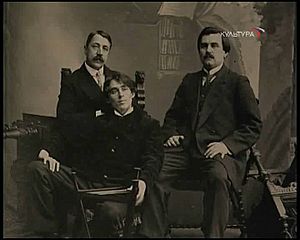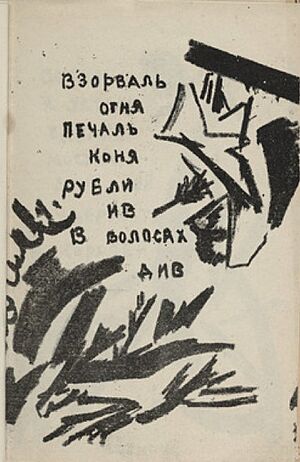Aleksei Kruchyonykh facts for kids
Quick facts for kids
Aleksei Kruchyonykh
|
|
|---|---|

Mikhail Matyushin (left), Kruchenykh (middle) and Kazimir Malevich (right) at the First All-Russian Congregation of the Bards of the Future (The Futurist Poets) meeting in March 1912. Photo by Karl Bulla.
|
|
| Born |
Aleksei Yeliseyevich Kruchonykh
9 February 1886 Olevka, Kherson Governorate, Russian Empire
|
| Died | 17 June 1968 (aged 82) |
| Nationality | Russian |
| Known for | Poetry, Collage, Artist's book |
|
Notable work
|
Universal War, 1916 |
| Movement | Russian Futurism, Zaum |
Aleksei Yeliseyevich Kruchyonykh (Russian: Алексе́й Елисе́евич Кручёных; 9 February 1886 – 17 June 1968) was a Russian poet, artist, and thinker. He was one of the most daring poets of Russian Futurism. This was an art movement that included famous names like Vladimir Mayakovsky and David Burliuk.
Born in 1886, Aleksei lived during a special time for Russian literature. He and Velimir Khlebnikov, another Futurist, created a new poetry style called zaum. This style used made-up, nonsense words to create new meanings.
Kruchyonykh wrote the story for the Futurist opera Victory Over the Sun. The famous artist Kazimir Malevich designed the sets for it. In 1912, Aleksei wrote the poem Dyr bul shchyl. Four years later, in 1916, he made his most famous book, Universal War.
He also wrote a famous statement in 1913 called Declaration of the Word as Such. He believed that old words had lost their power. He said, "The old word 'lily' has no feeling left. So I call the lily éuy – and its original purity comes back."
Contents
Who Was Aleksei Kruchyonykh?
Aleksei Kruchyonykh was born on 21 February 1886, in a farming family in the Kherson region of Russia. He first wanted to be an artist. He studied at the Odessa Art School and the Moscow School of Painting, Sculpture and Architecture. To earn money, he drew cartoons and showed his art sometimes.
But in 1912, he decided to become a poet instead. Soon after, he met the Burliuk brothers. He quickly became an important poet in Cubo-Futurism. This was a new art style he helped start with friends like David Burliuk, Vladimir Mayakovsky, and Mikhail Larionov.
Creating New Art Styles
Kruchyonykh helped write a famous Cubo-Futurist statement called A Slap in the Face of Public Taste in 1912. This paper famously said they wanted to throw old writers "off the steamboat of modernity."
His poem Dyr bul shchyl was the first example of zaum poetry. It was published in a 1913 book called Pomada. He and Velimir Khlebnikov are seen as the inventors of this unique poetry style. Kruchyonykh was also the first Russian poet to write a poem using only vowel sounds.
He became one of the most active Cubo-Futurist writers. His books were often printed by hand and had drawings by other Futurists. Some titles included A Little Duck's Nest of... Bad Words and Explodity. He also worked with artists like Olga Rozanova. Together, they created samopismo, a Futurist book where words and pictures were truly connected.

The Opera Victory Over the Sun
One summer, Aleksei went to the home of composer Mikhail Matyushin with Kazimir Malevich. They worked together to create the Futurist opera Victory over the Sun. Matyushin wrote the music, Khlebnikov wrote the introduction, and Kruchyonykh wrote the story. Malevich designed the sets.
This opera is his most famous work. It's about a group of Futurists who capture the sun and challenge gravity. The opera first opened at the Luna Park Theatre in St. Petersburg. It was organized by the Union of the Youth.
The play used zaum language and cardboard costumes. A real airplane and pilot even appeared on stage! The audience often booed, and the show caused a lot of shock. Kruchyonykh and his friends also surprised people during their poetry readings. Sometimes, he had to use his shoes to stop angry audience members from attacking him.
Later Life and Works
His book Universal War was published in 1916. He drew the abstract collages for it himself. During the war, he worked as a technical draftsman, drawing plans.
After the October Revolution in 1917, he moved to Tiflis, Georgia. He was part of a railway building team. There, with his friend Ilia Zdanevich, they started an art group called 41°. The number referred to a high fever, showing their intense artistic spirit.
After Zdanevich left Georgia, Kruchyonykh returned to Russia in 1921. He published more books, wrote essays, and gave talks. Later in his life, it became harder for him to publish his works. So, he sometimes made his own books. He also worked as an archivist and collected rare books and writings by artists of his time. He passed away from pneumonia in 1968.
How Is He Remembered?
Aleksei Kruchyonykh's unique ideas continue to influence artists. The Russian punk band Grazhdanskaya Oborona has a song called "Posveshtenie A. Kruchyonykh" (Homage to A. Kruchyonykh). It's on their 1990 album Instruktsiya po vyzhivaniyu.

